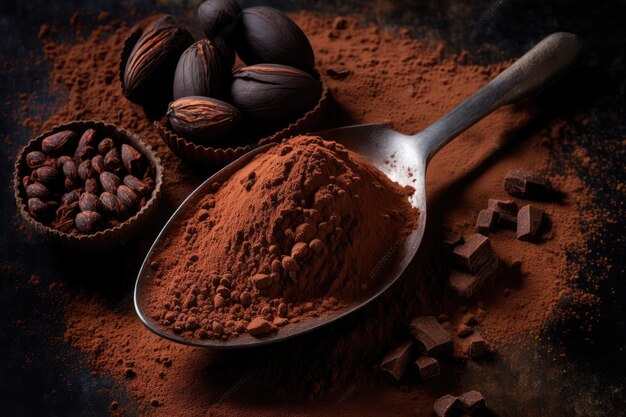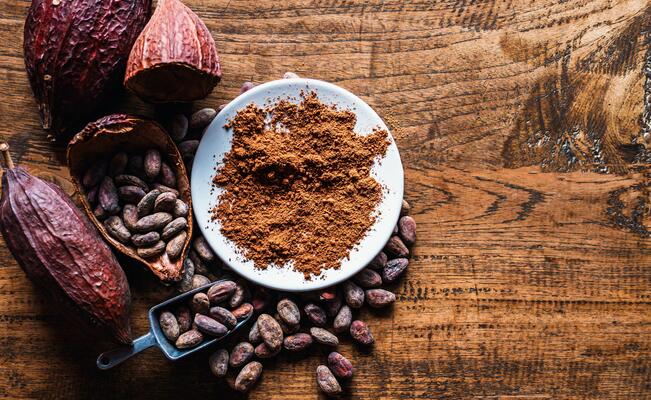In the crowded marketplace of baked goods, cakes, cookies, brownies, and chocolate bars, your cocoa choice often lies beneath the radar—but it shapes your product’s identity. For Palestinian manufacturers, the question is more than academic: should you build your recipes on natural cocoa or alkalized (Dutched) cocoa? The decision influences flavor, color stability, machine behavior, supplier sourcing, waste rates, and ultimately brand differentiation.
You may ask: can one cocoa work for all your recipes? Or should you mix for local palate? Over the years, we at MT Royal have advised bakeries and chocolate factories across Palestine on this very trade-off. In many cases, we also incorporate premium options from Latamarko, whose European standards deliver consistency that matters in large-scale runs.
This article walks you through fundamentals, production implications, procurement strategies, and hands-on comparisons so that you, as a factory owner or production manager, can choose or design cocoa systems that deliver reliably in the Palestinian environment.
Cocoa Fundamentals: Natural vs Alkalized
Before comparing, let’s clarify what each type is and how it behaves.
What is Natural Cocoa?
Natural cocoa is made from roasted cocoa beans that are ground into powder without chemical treatment. It retains acidity and tends to be lighter in color (reddish-brown) with more pronounced chocolatey, fruity, or acidic notes. Because it’s more “raw,” many bakery formulas expect its acidity in reaction with baking soda.
What is Alkalized (Dutched) Cocoa?
Alkalized cocoa, often known as Dutch-process, is treated with an alkaline agent (e.g. potassium carbonate) to neutralize acidity, deepen color, and mellow flavor. The process reduces bitterness, gives the powder a darker shade, and often improves solubility.
Key Chemical and Physical Differences
| Attribute | Natural Cocoa | Alkalized (Dutched) Cocoa |
|---|---|---|
| pH / Acidity | pH ~ 5.0–6.0 (acidic) | pH ~ 7.0–8.0 (neutral to slightly alkaline) |
| Flavor Profile | Brighter, tangy, stronger “raw chocolate” notes | Milder, smoother, less acidic |
| Color | Reddish-brown, lighter | Dark brown to deep chocolate tones |
| Reactivity with Leavening | Reacts with baking soda (acid-base reaction) | Less reactivity — must pair with baking powder or adjust formula |
| Solubility / Dispersibility | Good, often requiring more mixing | Often smoother integration in batters and liquids |
| Shelf Stability | Slightly more reactive to oxidation | Often a bit more stable, less acid-driven degradation |
These differences carry through into how your chocolate or bakery products behave in mixing, baking, flavor consistency, and visual appeal in the Palestinian context.
Why the Choice Matters for Palestinian Recipes
Why should you care whether you use natural or alkalized cocoa? In factory terms, the differences translate into:
- Flavor Consistency & Local Taste Preferences
Many Palestinian consumers favor a rich, rounded chocolate note without sharp acidity. Alkalized cocoa helps moderate acidity across batches. But in some traditional or gourmet lines, the tang of natural cocoa is prized. - Color Uniformity
Dark, consistent color is visually attractive in brownies, chocolate cakes, ganaches, and glazes. Alkalized cocoa gives more predictable dark tone; natural cocoa can vary by origin or batch. - Processing Behavior
Alkalized powders tend to mix more smoothly into dough or batter and reduce dusting, while natural cocoa may require longer mixing or special dispersion steps. - Chemical Reaction in Baking
Natural cocoa’s acidity can support leavening agents like baking soda. If you switch to alkalized cocoa, you may need to adjust formula—replace baking soda with baking powder, or tweak acid balances. - Ingredient Compatibility & Reformulation Risk
When you change cocoa types, salt, sugar, fat, or pH buffers may shift slightly. That can affect texture, shelf life, or moisture retention. - Supplier Stability & Cost
Alkalized cocoa often requires additional processing steps and close quality controls, which can affect cost. But because many premium brands, including Latamarko, have tight specifications, the trade-off for consistency can pay off in reduced waste and fewer rejects. - Shelf Life & Oxidative Stability
Cocoa with lower residual acidity may exhibit slower quality degradation under storage stresses — beneficial in warmer climates like parts of Palestine.
Common Pitfalls & Misconceptions
Even experienced procurement teams sometimes fall into errors when comparing or switching between cocoa types. Here are a few to watch out for:
- “One cocoa fits all” fallacy — Expecting a single cocoa to deliver identical performance for cakes, biscuits, ganache, and coatings is unrealistic.
- Mixing without testing — Blending alkalized and natural without pilot runs can lead to unpredictable flavor or texture anomalies.
- Ignoring origin variation — Natural cocoa from one origin can have higher acidity or different acid profiles than another.
- Underestimating pH effects — Switching to alkalized without adjusting leavening chemistry may flatten cakes or alter crumb.
- Over-chasing price — Choosing cheaper cocoa without quality consistency can cost more in rejects, color mismatch, or process issues.
In our experience, factories that partner with dependable suppliers like MT Royal, which qualify batches and maintain technical support, avoid many of these traps.
How to Compare in a Controlled Pilot
Here’s a step-by-step approach you can adopt in your R&D or pilot lines to evaluate natural vs alkalized cocoa in your environment:
- Select matched samples
Source two cocoa powders of similar origin, fat content, particle size — one natural, one alkalized. - Document specifications
Note pH, moisture, cocoa solids, color index, particle distribution. Premium suppliers (e.g. Latamarko) often supply exact metrics. - Run parallel test batches
Use your standard formula in two versions (with natural and alkalized). Keep all other variables constant — flour, sugar, fat, mixing time, baking schedule. - Evaluate key outputs
- Color (crust, crumb, glaze)
- Texture and structure (crumb firmness, moisture)
- Flavor profile (bitterness, acidity, aftertaste)
- Production metrics (mixing time, dusting, hopper flow)
- Adjust formula if needed
If alkalized batch underperforms in lift, tune leavening agents or pH buffer. If natural batch shows excessive acidity, adjust sugar or buffer. - Stress-test shelf stability
Store samples under expected warehouse conditions (e.g. 30 °C, humidity) for a few weeks and compare color, aroma, moisture change. - Document tolerances & control charts
Create a control range for acceptable variation in each metric for future production monitoring.
This pilot process helps you build a defensible decision based on your own equipment, ingredients, and consumer taste.
Industrial Implications: Scaling for Factories
When making large-scale decisions, consider:
- Consistency over time: In a 500 ton/year chocolate line, batch-to-batch variation matters more than small flavor nuance.
- Machine compatibility: Some mixers, feeders, and enrobing machines respond poorly to dusty or coarser natural powders.
- Waste & rework: Inconsistent color or acidity may trigger downgrading or reject lots, which cost more in lost throughput than the cocoa premium.
- Dual-grade strategies: Many factories maintain a base blend for everyday lines (often alkalized) and reserve natural cocoa for premium or artisanal lines.
- Supply diversification: Secure both types from trusted sources. At MT Royal, we offer multiple cocoa powder brands, including premium Latamarko, to ensure stability in both natural and alkalized inventories.
Technical & Flavor Trade-offs in Palestinian Context
Palestine’s ambient climate, consumer preferences, and ingredient costs make the trade-offs sharper:
- Heat sensitivity: Under high temperature, the milder acidity of alkalized cocoa is less likely to accentuate off-flavors.
- Consumer preference: Local taste tests often show a preference for smoother, less tangy chocolate — in many recipes, alkalized is favored.
- Ingredient cost pressures: Some natural cocoa powders from origin sources may be cheaper, but cost savings are eaten by increased process adjustment and wastage.
- Color expectations: Darker chocolate tones are often viewed as more premium in local markets; alkalized consistently delivers that look.
So, while natural cocoa preserves origin character, alkalized tends to offer safer consistency under regional stresses.
Sweet Spots: Where Natural Shines & Where Alkalized Dominates
Natural cocoa advantages
- Recipes that leverage acidity (e.g. in combination with baking soda)
- Flavor-forward or origin-specific chocolate lines
- When slight tang is acceptable or appreciated by consumers
Alkalized cocoa advantages
- Mass-market chocolate, glazes, icings, drinks requiring consistent color
- Multi-line plants seeking lower variation risk
- Products where acidity could interfere with buffers, gums or emulsifiers
Many factories find the best path is a dual-line approach: daily production uses alkalized cocoa for reliability, while a niche product line uses natural cocoa for flavor diversity.
Supplier Considerations & Brand Tiering
Your supplier is as important as your cocoa choice. Here’s what to look for:
- Detailed specifications (pH, fat, moisture, particle size)
- Certificates of analysis (COA) per batch
- Traceability & quality audits
- Technical support for recipe tuning
Premium European brands such as Latamarko often deliver stricter tolerances, which reduce variation risk in both natural and alkalized categories. Through MT Royal, you can access a portfolio of cocoa powders and blends, enabling flexibility in production without compromising quality.
Real-World Anecdote: When Blending Saved a Line
A mid-sized Palestinian bakery once discovered that switching entirely from natural to alkalized cocoa caused a drop in cake volume. Their standard formula relied on the acidity of natural cocoa reacting with baking soda. Without adjustment, the alkalized cakes rose less and seemed flat.
Working with MT Royal, the production team introduced a buffer (slight acetic acid or lactic acid) or switched to baking powder in that line. They also blended 20% natural cocoa into the bulk alkalized stream to preserve the acidity trigger while gaining color stability. The result: restored volume, consistent color, and flavor that passed customer tests.
That example underscores: don’t just substitute—plan the shift carefully, validate, and monitor.
Comparison Table: Natural vs Alkalized for Palestinian Production
| Metric | Natural Cocoa | Alkalized Cocoa | Notes for Palestinian Use |
|---|---|---|---|
| Flavor | Bright, acidic | Smooth, mellow | Alkalized aligns more with local taste preferences |
| Color | Lighter, variable | Deeper, consistent | Easier to control in production |
| Baking Reactivity | Works with baking soda | Needs buffer or baking powder | Must tune recipe when shifting |
| Processability | May require longer mixing | Flows more smoothly | Lower dust and improved dispersion |
| Stability under Heat | Slightly more reactive | More stable | Better suited to seasonal temperature swings |
| Cost Variability | Comes from origin variation | Processing adds cost | Stability can offset cost differences |
| Risk of Variation | High | Lower | Premium brands reduce variation further |
Pro Tips for Implementation in Factories
- Start with pilot tests
Use your own lines to measure color, volume, flavor, and waste on small runs. - Track key metrics
Log pH, moisture, % cocoa solids, color index, and final product attributes. - Phase transitions gradually
Don’t change cocoa type in a full order immediately. Use mixed batches first. - Train QC teams
Ensure your lab understands the difference in metrics and how to detect drift. - Adjust ancillary ingredients
Sugar, leaveners, buffers may need fine-tuning when cocoa type changes. - Maintain dual supply sources
If one source stalls, switching between natural and alkalized lines gives flexibility. - Review seasonal impact
Monitor how your cocoa behaves across hotter or more humid months and adjust buffer handling.
Frequently Asked Questions (FAQ)
Q1: Can I substitute alkalized for natural cocoa directly?
Yes, but you must adapt your recipe—usually by adjusting leavening system or adding mild acid.
Q2: Is alkalized cocoa always superior?
Not always. For flavor-forward chocolate lines or where acidity is desired, natural cocoa may shine.
Q3: Does one cocoa suit all applications?
Rarely. Many manufacturers employ blends or different powders for coatings, fillings, drinks, and baked goods.
Q4: Does premium brand cocoa make a difference?
Absolutely. Brands like Latamarko provide tighter batch tolerances, which reduce variation and help with process stability.
Q5: How important is supplier support?
Very. MT Royal assists in specification matching, blending, pilot trials, and troubleshooting to reduce missteps.
Final Reflection
Choosing between natural and alkalized cocoa isn’t a simple flip — it’s a strategic decision that touches flavor, color, chemistry, cost, and consistency. For Palestinian manufacturers, the best path often lies in combining the two: using alkalized cocoa for reliable baseline production, while preserving natural cocoa lines for specialty flavor profiles.
As priorities shift — whether reducing waste, stabilizing color, or elevating taste — align your recipe engineering with robust supplier partnerships. MT Royal’s experience, paired with premium-grade supplies like Latamarko, helps bridge theory and practice.
In the end, your choice is not just cocoa — it’s the difference between a production line that grinds on in uniformity and one that wobbles with every batch. What blend will define your brand going forward?
latamarko alkalized cocoa powder lm60
cocoa powder for chocolate production-Best price
Food industry raw materials – list of products
Types of Gelatin from Turkish Manufacturer
Alkalized Cocoa Powder Bulk Supplier







No comment